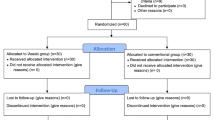Abstract
Introduction
A novel hand-held navigation combines gyroscopes, accelerometers and a secure local wireless channel to guide the distal femoral and proximal tibial cutting positions by displaying to the surgeon directly on the pods within the surgical field. No previous study has reported on its accuracy.
Materials and methods
A prospective randomized controlled trial was performed to compare radiographic outcomes in minimally invasive surgery total knee arthroplasty (MIS-TKA) with (40 patients, 40 knees) and without (40 patients, 40 knees) the novel hand-held navigation.
Results
The use of hand-held navigation resulted in fewer outliers (> ± 3° malalignment) in all frontal alignment: the hip-knee-ankle, the femoral component, and the tibial component. Tibial slope was also better achieved with the navigation. Femoral component flexion was not significantly different. Operation time and bone cutting time with the navigation were not longer than those without. Blood loss from drainage was not significantly different.
Conclusion
The hand-held navigation improves accuracy for mechanical alignment and positioning of the prosthesis without additional surgical time.




Similar content being viewed by others
References
Ritter MA, Faris PM, Keating EM, Meding JB (1994) Postoperative alignment of total knee replacement. Its effect on survival. Clin Orthop Relat Res 299:153–156
Longstaff LM, Sloan K, Stamp N, Scaddan M, Beaver R (2009) Good alignment after total knee arthroplasty leads to faster rehabilitation and better function. J Arthroplasty 24(4):570–578. doi:10.1016/j.arth.2008.03.002
Jeffery RS, Morris RW, Denham RA (1991) Coronal alignment after total knee replacement. J Bone Joint Surg (Br) 73(5):709–714
Brin YS, Nikolaou VS, Joseph L, Zukor DJ, Antoniou J (2011) Imageless computer assisted versus conventional total knee replacement. A Bayesian meta-analysis of 23 comparative studies. Int Orthop 35(3):331–339. doi:10.1007/s00264-010-1008-6
Jung KA, Lee SC, Ahn NK, Song MB, Nam CH, Shon OJ (2011) Delayed femoral fracture through a tracker pin site after navigated total knee arthroplasty. J Arthroplasty 26(3):505 e509–505 e511. doi:10.1016/j.arth.2010.01.006
Insall JN, Dorr LD, Scott RD, Scott WN (1989) Rationale of the Knee Society clinical rating system. Clin Orthop Relat Res 248:13–14
Kim YH, Kim JS, Yoon SH (2007) Alignment and orientation of the components in total knee replacement with and without navigation support: a prospective, randomised study. J Bone Joint Surg (Br) 89(4):471–476. doi:10.1302/0301-620X.89B4.18878
Bauwens K, Matthes G, Wich M, Gebhard F, Hanson B, Ekkernkamp A, Stengel D (2007) Navigated total knee replacement. A meta-analysis. J Bone Joint Surg Am 89(2):261–269. doi:10.2106/JBJS.F.00601
Manzotti A, Cerveri P, Pullen C, Confalonieri N (2014) Computer-assisted unicompartmental knee arthroplasty using dedicated software versus a conventional technique. Int Orthop 38(2):457–463. doi:10.1007/s00264-013-2215-8
Saragaglia D, Picard F, Refaie R (2012) Navigation of the tibial plateau alone appears to be sufficient in computer-assisted unicompartmental knee arthroplasty. Int Orthop 36(12):2479–2483. doi:10.1007/s00264-012-1679-2
Maderbacher G, Schaumburger J, Keshmiri A, Barthel M, Springorum HR, Craiovan B, Grifka J, Baier C (2015) Pinless navigation in total knee arthroplasty: Navigation reduced by the maximum? Int Orthop 39(3):455–460. doi:10.1007/s00264-014-2529-1
Lachiewicz PF, Henderson RA (2013) Patient-specific instruments for total knee arthroplasty. J Am Acad Orthop Surg 21(9):513–518. doi:10.5435/JAAOS-21-09-513
Russell R, Brown T, Huo M, Jones R (2014) Patient-specific instrumentation does not improve alignment in total knee arthroplasty. J Knee Surg. doi:10.1055/s-0034-1368143
Thienpont E, Schwab PE, Fennema P (2014) A systematic review and meta-analysis of patient-specific instrumentation for improving alignment of the components in total knee replacement. Bone Joint J 96-B(8):1052–1061. doi:10.1302/0301-620X.96B8.33747
Lackey WG, Berend ME (2012) Hand-held navigation in total knee arthroplasty. J Bone Joint Surg (Br) 94(11 Suppl A):151–152. doi:10.1302/0301-620X.94B11.30831
Nam D, Weeks KD, Reinhardt KR, Nawabi DH, Cross MB, Mayman DJ (2013) Accelerometer-based, portable navigation vs imageless, large-console computer-assisted navigation in total knee arthroplasty: a comparison of radiographic results. J Arthroplasty 28(2):255–261. doi:10.1016/j.arth.2012.04.023
Nam D, Cross M, Deshmane P, Jerabek S, Kang M, Mayman DJ (2011) Radiographic results of an accelerometer-based, handheld surgical navigation system for the tibial resection in total knee arthroplasty. Orthopedics 34(10):e615–e621. doi:10.3928/01477447-20110826-12
Khan H, Walker PS, Zuckerman JD, Slover J, Jaffe F, Karia RJ, Kim JH (2013) The potential of accelerometers in the evaluation of stability of total knee arthroplasty. J Arthroplasty 28(3):459–462. doi:10.1016/j.arth.2012.07.025
Scuderi GR, Fallaha M, Masse V, Lavigne P, Amiot LP, Berthiaume MJ (2014) Total knee arthroplasty with a novel navigation system within the surgical field. Orthop Clin North Am 45(2):167–173. doi:10.1016/j.ocl.2013.11.002
Acknowledgments
The patients’ expenses for the TKA were covered by a public healthcare program. NK received a scholarship for her MS study from Thailand Graduate Institute of Science and Technology (TGIST), TG-CPMO 01-56-008.
Conflict of interest
ST is a paid consultant for Zimmer. The remaining authors declare that they have no conflict of interest.
Compliance with ethical standards
All procedures performed in studies involving human participants were in accordance with the ethical standards of the institutional and/or national research committee and with the 1964 Helsinki Declaration and its later amendments or comparable ethical standards.
Informed consent
Informed consent was obtained from all individual participants included in the study.
Author information
Authors and Affiliations
Corresponding author
Rights and permissions
About this article
Cite this article
Thiengwittayaporn, S., Fusakul, Y., Kangkano, N. et al. Hand-held navigation may improve accuracy in minimally invasive total knee arthroplasty: a prospective randomized controlled trial. International Orthopaedics (SICOT) 40, 51–57 (2016). https://doi.org/10.1007/s00264-015-2848-x
Received:
Accepted:
Published:
Issue Date:
DOI: https://doi.org/10.1007/s00264-015-2848-x




